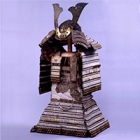本館 14室
2015年4月7日(火) ~ 2015年7月5日(日)
島根半島の西端に鎮座する日御碕神社(ひのみさきじんじゃ)には、甲冑・刀剣・典籍などの宝物が伝えられています。なかでも国宝 白糸威鎧(しろいとおどしのよろい)と重要文化財 黒韋肩裾取威腹巻(くろかわかたすそどりおどしのはらまき)は、昭和28年(1953)から当館に出品寄託をいただき、展示をしてまいりました。
白糸威鎧は、江戸時代には源頼朝奉納の甲冑として知られていました。幕末には威糸(おどしいと)などが傷んでいたため、文化2年(1805)、当時の松江藩主松平治郷(まつだいらはるさと)の命によって江戸で修理され、往年の姿を損なうことなく現在の形に仕立てられました。その際、破損部分の繕いには「文化二年修補」の文字を染めた白韋(しろかわ)が用いられ、取り外された威糸や紐などの残欠類は別に保管されました。また修理を担当した寺本安宅によって61ヶ条の修理記録「源頼朝卿御鎧修補註文」が記されています。このような治郷の宝物に対する姿勢は、現在の文化財の修理に通じるひとつの規範を示しています。
この特集では、今まで公開する機会のなかった残欠類や註文、修理前の様子を写した模写図などをまとめて陳列いたします。白糸威鎧にならって安政3年(1856)に修理された黒韋肩裾取威腹巻とあわせて日御碕神社の甲冑の模写図や修理について紹介いたします。

